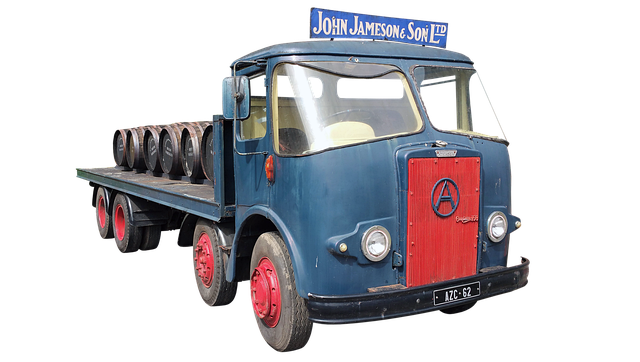Registering Your Car in California: Step-by-Step Guide
Registering a car in California involves understanding specific requirements, gathering essential documents, and completing either an online or in-person process. The key step is DMV VIN verification,…….

Registering a car in California involves understanding specific requirements, gathering essential documents, and completing either an online or in-person process. The key step is DMV VIN verification, which ensures your vehicle meets safety standards. First, collect necessary papers for the VIN (Vehicle Identification Number) check. Then, you can either navigate the online registration process or visit a DMV office. Prepare for a vehicle inspection and title transfer, followed by finalizing your car’s registration and securing crucial documents.
- Understand the Requirements for Car Registration in California
- Gather Necessary Documents for DMV VIN Verification
- Complete the Online Registration Process or Visit a DMV Office
- Prepare for the Vehicle Inspection and Title Transfer
- Finalize Your Car's Registration and Obtain Essential Documents
Understand the Requirements for Car Registration in California

Before you begin the registration process, it’s crucial to understand what’s required for car registration in California. The California Department of Motor Vehicles (DMV) has strict guidelines that must be met to ensure vehicle safety and identity verification. One of the primary steps is the DMV VIN verification, which confirms the vehicle’s unique identification number (VIN) through a comprehensive inspection. This process helps prevent fraud and ensures that all vehicles on California roads meet safety standards.
Additionally, you’ll need to provide essential documents such as proof of insurance, a valid driver’s license, and possibly, depending on your situation, a title or bill of sale. Some methods for vin inspection are available, including mobile vin verifier services that can come to you, streamlining the process further. However, it’s important to stay informed about local regulations and ensure all documents and verifications are in order before visiting a DMV office.
Gather Necessary Documents for DMV VIN Verification

Before heading to the California DMV for registration, make sure you have all the required documents for a successful dmv vin verification. This process is crucial for establishing the vehicle’s history and ensuring its authenticity. Gather the following: your valid driver’s license or state ID, proof of insurance, and the title or lienholder information if applicable. Additionally, you’ll need to provide a mobile vin verifier or have the vehicle’s VIN (Vehicle Identification Number) readily available for a quick vin inspection.
It’s advisable to double-check that your documents are in order, as the dmv vin verification is a critical step in the registration process. Having accurate and up-to-date information ensures a smooth transition from owner to registered vehicle, allowing you to hit the road legally and confidently.
Complete the Online Registration Process or Visit a DMV Office

You have two options for registering your car in California: complete the process online or visit a DMV office. Both methods require accurate information and documentation, including proof of ownership and vehicle identification number (VIN) verification. For those opting to go digital, the Online Registration Process offers a convenient, step-by-step guide to fill out forms and upload necessary documents, like proof of insurance and vehicle title.
DMV’s VIN verification is crucial in ensuring the accuracy of your car’s information. You can use a mobile vin verifier for this purpose, which provides a quick and easy way to confirm the details of your vehicle before completing registration. Alternatively, if you choose to visit a DMV office, staff members can conduct a vin inspection on-site to ensure all data matches before processing your registration.
Prepare for the Vehicle Inspection and Title Transfer

Before you can register your car in California, you’ll need to ensure that your vehicle passes a thorough inspection. This involves both a visual check and a DMV VIN verification process. Start by gathering all necessary documents, including your vehicle’s registration, proof of insurance, and identity paperwork. Then, prepare for the inspection by ensuring your car is in good working condition, with no obvious mechanical issues or safety hazards.
For convenience, many services offer mobile VIN inspectors who can perform the DMV VIN verification on-site. This includes checking the vehicle’s history, identifying any outstanding issues, and confirming that the VIN (Vehicle Identification Number) matches the details in the title transfer documents. A mobile vin inspection ensures a smoother process, saving you time and potential headaches later.
Finalize Your Car's Registration and Obtain Essential Documents

After completing your vehicle’s purchase and ensuring all necessary inspections, it’s time to finalize its registration. In California, this process involves a few key steps. First, you’ll need to schedule and conduct a DMV (Department of Motor Vehicles) VIN (Vehicle Identification Number) verification, which can be done online or in-person. This step is crucial as it confirms your car’s authenticity and history, ensuring compliance with state regulations. During the inspection, a professional will check various aspects, including the vehicle’s title, odometer reading, and any reported damage or accidents.
Once your car passes this verification, you can proceed to gather all essential documents. This typically includes your purchase agreement, proof of insurance, and a valid driver’s license. With these in hand, you’re ready to complete the registration process at your local DMV office. They will issue a registration certificate and license plate, officially making your vehicle registered and roadworthy in California. Don’t forget that some areas offer the option of a mobile VIN inspection or using a mobile vin verifier for added convenience when registering your new car.
Registering a car in California involves understanding specific requirements, gathering essential documents like a vehicle identification number (VIN) for DMV VIN verification, and either completing an online process or visiting a DMV office. After preparing for the vehicle inspection and title transfer, you can finalize your car’s registration and obtain all necessary documents. Following these steps ensures a smooth transition to California roads.







